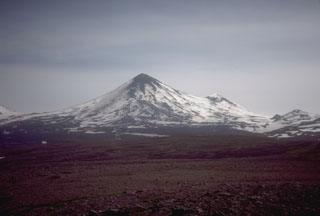Report on Pavlof (United States) — October 1976
Natural Science Event Bulletin, vol. 1, no. 13 (October 1976)
Managing Editor: David Squires.
Pavlof (United States) Ash covering upper slopes and the cone
Please cite this report as:
Global Volcanism Program, 1976. Report on Pavlof (United States) (Squires, D., ed.). Natural Science Event Bulletin, 1:13. Smithsonian Institution. https://doi.org/10.5479/si.GVP.NSEB197610-312030
Pavlof
United States
55.417°N, 161.894°W; summit elev. 2493 m
All times are local (unless otherwise noted)
10 September, 1520-1523: "smoke" emission with some intermixed ash. Ash deposits were noted on the SE slope. 22 September, 0745-1200: no activity. Lower slopes were snow-covered, the upper slopes were "dark," and the cone was black. 28 September, 0750-0843: a steady 150-m steam plume was observed. The cone was ash-covered, but snow blanketed the rest of the mountain.
Geological Summary. The most active volcano of the Aleutian arc, Pavlof is a Holocene stratovolcano that was constructed along a line of vents extending NE from the Emmons Lake caldera. Pavlof and Pavlof Sister to the NE form a dramatic pair of symmetrical, glacier-covered stratovolcanoes that overlook Pavlof and Volcano bays. Little Pavlof is a smaller cone on the SW flank of Pavlof volcano, near the rim of Emmons Lake caldera. Unlike Pavlof Sister, eruptions have frequently been reported from Pavlof, typically Strombolian to Vulcanian explosive eruptions from the summit vents and occasional lava flows. The active vents lie near the summit on the north and east sides. The largest recorded eruption took place in 1911, at the end of a 5-year-long eruptive episode, when a fissure opened on the N flank, ejecting large blocks and issuing lava flows.
Information Contacts: R. Dean, USAF, Cold Bay.

